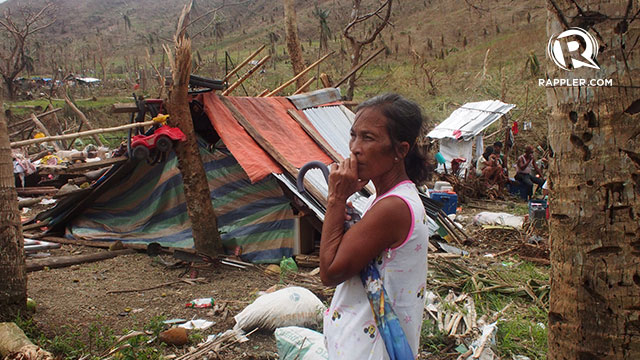SUMMARY
This is AI generated summarization, which may have errors. For context, always refer to the full article.

Two women, hearts broken, hands bruised and bleeding, their faces smeared by tears that fall silently at every hint of memory and by the grime that rises from piled fragments of former homes: one, Marcelina Gallano, an overseas worker in Dubai, clawing through rubble to search for the body of her only daughter Girly; the other, Rhodora Tiongson, who started a life in Bantayan Island after she fled a husband who battered her, hammering scraps of wood and tarp to build herself a shelter.
These are the people whose lives Typhoon Haiyan destroyed, but remain brave enough to hope for some kind of future. For them and four million others displaced by the disaster, each day spent on the struggle to survive is a day just that – a struggle.
One month on: a snapshot of the response
On 8 Nov 2013, Typhoon Haiyan ploughed through central Philippines from east to west, throwing almost 15 million people across nine regions into chaos and uncertainty. One month on, close to 2,000 people are still missing, 5,719 are recorded dead and the number is rising as more bodies are recovered. The government pegged the total cost of damage at PhP34B. The first phase of the UN Office for the Coordination of Humanitarian Affairs’ (OCHA) humanitarian appeal stands at $348M, and is due to be revised upwards soon.
Overcoming extraordinary challenges, a massive relief effort led by Philippines authorities is helping millions of people survive and recover. An estimated 3M people had received food assistance. Over 11,300 households had received seeds, fertilizer and agricultural tools. More than 36,000 households have tarpaulin sheets or tents. Efforts to reach another 400,000 households are underway. About 80% of people still in Tacloban City now have access to clean water, while about 60,000 hygiene kits have been distributed altogether. These plus health care, protective services and cash transfers are helping keep families alive, prevent outbreaks of disease and are begin to slowly rebuild livelihoods.
But there remains a long way to go. The response needs to expand fast to reach communities, especially in remote rural areas. An OCHA assessment in Leyte found people in some barangays reported eating “one small meal” every other day. Of the 4 million people displaced, some have returned to build makeshift shelters, while others continue to leave the worst-hit areas. For many, the lack of affordable shelter and construction materials delays their return; in some places, building materials have doubled in price.
To be poor is to be vulnerable
To struggle for dignity and decency is not new to the likes of Marcelina and Rhodora. Eastern Visayas is the country’s third poorest region, and first on the list of areas with the highest income inequality. Farmers and fisherfolks are poor because agriculture suffers from chronic underinvestment. The inadequacy of infrastructure and transport is an obstacle to inclusive economic growth, and a hindrance to disaster relief efforts. Agrarian reform is weakly implemented. Lack of tenurial security also threatens farming and fishing households. Poor people search for better opportunities, but many, however, still end up poor.

Women face obstacles here, despite the Philippines being ranked 5th in the world for narrowing the gender gap. Gender inequalities in access to resources, entitlements, and the division of household labor make rural women the poorest of the poor in Eastern Visayas. Such poverty has made women and children vulnerable to human trafficking, and earned for Eastern Visayas the notoriety of a hotspot.
The record-breaking strength of Typhoon Haiyan brought inescapable devastation in its wake; but poverty and inequality were the underlying causes of vulnerability for the majority of the displaced.
Recovery, rehabilitation, risk-reduction
The humanitarian response is still gathering pace, but President Benigno Aquino has already approved a 3-phase rehabilitation plan, and appointed former Senator Panfilo Lacson to lead the rehabilitation.
Rehabilitating the storm-ravaged areas presents a valuable opportunity for addressing the very conditions that make poor people vulnerable. Already, no-build zones along foreshore lands are being mentioned, and the relocation and resettlement of fisherfolk communities implied, since municipal fishers usually establish their settlements here. But the enactment of the Philippine Fisheries Code in 1998 stipulates the zoning of fisherfolk settlements near fishing grounds, and protects their rights to settlements along areas where their livelihoods depend.
Relocation and resettlement issues must be consulted and agreed with fishing communities, for without access to the sea, they will wither and die. The Department of Agriculture placed the total number of affected farming and fishing households at 202,410, or a total of 865,305 individuals or 22% of those displaced.
Fisherfolk settlement areas must be assigned as part of a comprehensive land use plan developed and agreed with them by the local government. Discussion of less risky settlement areas for fishing communities must be done not only in consideration of their marine-based livelihoods, but also of their role as stewards and resource managers.
Strong ecosystems and improved natural resource management support livelihoods and biodiversity, and provide environmental buffers. In Philippine coastal areas, rural women manage marine sanctuaries and mangrove forests. Mangroves can reduce storm surge levels by up to half a meter for each kilometer of mangrove that the storm surge passes through, and reduce the height of wind and swell waves by 13- 66% within the first 100m of mangroves.
If Typhoon Haiyan can move the National Land Use Act (NLUA) into law, it will do a lot to frontload risk reduction in development planning. Land use and physical planning must identify, determine and evaluate appropriate land use, and allocation patterns such that disaster risk reduction, climate-risk based planning, and the meaningful participation of the basic social sectors are promoted. People’s participation is crucial since NLUA also states that settlements within geohazard areas shall not be allowed.
Lessons from Typhoon Ketsana
Lessons abound from Typhoon Ketsana. Take the municipal and provincial governments of Rizal and Laguna where effective local institutions and partnerships with communities and civil society led to a step change in risk reduction. The political commitment of the government and the engagement and cooperation of people were the most crucial in the change.
Technical fixes are important but real rebuilding starts here, in improving the capacity of communities and local governments. In a region with major deficiencies in delivering public services and targeting poverty reduction programs, national and local government must work shoulder-to-shoulder with a range of actors to pick up the pieces and rebuild a stronger, more resilient society. – Rappler.com
Lan Mercado is Oxfam’s Deputy Regional Director in Asia. She served as Oxfam’s Country Director in the Philippines from 2001-2009 and, later, ASEAN Advisor on Partnership and Resource Mobilization. This article was written with contributions from Shaheen Chugtai, Deputy Head of Oxfam’s Humanitarian and Security Issues Team, and research from Paht Tan-Attanawin, Oxfam Project Officer.
Add a comment
How does this make you feel?
There are no comments yet. Add your comment to start the conversation.